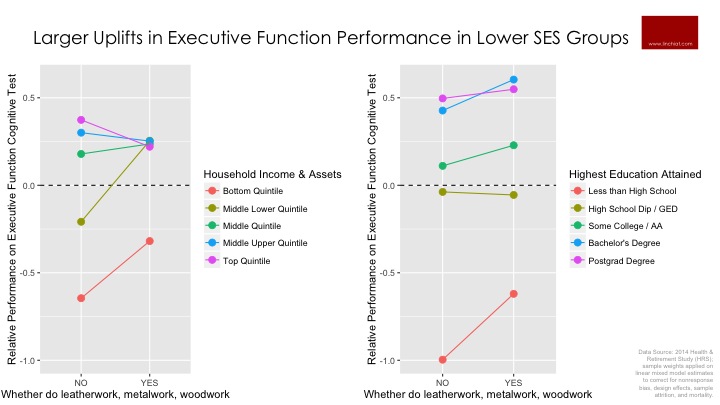This analysis examines how socioeconomic status moderates the relationship between arts participation and health on a diverse and nationally representative sample of older adults. Key findings:
- Creative aging is a social privilege in the USA
- Health benefits from creative arts vary by type of art form
- These benefits are most evident in lower socioeconomic groups
- Creative arts can complement other positive aging activities
A growing body of evidence from researchers working with music, dance, theater, visual arts, and creative story telling have suggested that arts-based interventions can have positive effects on physical, emotional and cognitive well-being (e.g., see reviews by Fraser et al. 2015, or Noice et al., 2014). But the prevalence of creative aging is not equal across different socioeconomic groups.
As shown in the chart above, a clear chasm exists in household wealth and education level between older adults who report participation in creative arts activities vs. those who do not. On average, older adults who reported no arts activity at all have significantly lower annual household income and assets, and are less likely to have received some college education. In short, creative aging is a social privilege in the USA.
There is also notable variance in socioeconomic attributes across the different art forms. For example, older adults who engage in photography and creative writing are more likely to have gone to college, while those who make needlecrafts or jewelry tend to have fewer years of schooling. Older adults who dance (includes social dancing) live in households with higher annual household income than those who paint or sing or play a musical instrument.
The HRS 2014 data gave us an amazing opportunity to quantify the strength of associations between creative arts and a broad array of wellness metrics. The above heat map compares older adults who do vs. do not engage in each creative art activity. We included measures of emotional well-being:
- general life satisfaction
- frequency of emotional distress (reverse coded)
- problems with sleep (reverse coded)
Measures of physical well-being:
- severity of chronic pain (reverse coded)
- self-assessment of personal health
Measures of cognitive performance:
- self-assessment of memory
- word recall test (immediate)
- word recall test (approx. 5 minutes delay)
- serial 7’s test, which reflects executive function
The stronger associations are represented by darker shades while the weaker associations are represented by the lighter shades. The strength of association score is simply the t-value reflecting the difference between two groups - older adults who engage in that art form vs. those who do not. Comparing across the columns, it is evident that Dance has the most consistent patterns across all the different metrics of wellness, suggesting that Dance has broad benefits across domains of cognitive, emotional, and physical well-being.
Deeper analysis could be conducted on any pairwise cell represented above. For now, we have selected the top 3 areas where we uncovered the strongest associations between creative arts engagement and wellness, namely:
- higher performance in word recall among older adults who weave, crochet, quilt, needlepoint, knit, sew, make jewelry etc. compared to their peers who do not engage in these creative crafts.
- more positive self-assessment of own health among older adults who dance vs. those who do not dance.
- higher performance in serial 7’s test among older adults who do leatherwork, metalwork, or woodwork, compared to their peers who do not.
As shown in the charts above, the largest gains in performance from creative arts engagement consistently emerged among older adults in lower socioeconomic groups. Even though older adults in lower socioeconomic groups are less likely to take up creative arts, those who do so are performing much better than their peers on multiple wellness metrics!
Research on healthy aging have uncovered other activities that correlate with enhanced functioning in older adults, such as physical exercise and volunteering (e.g. Pruchno et al. 2010, Foster & Walker, 2014). Thus we decided to explore how the potential benefits from creative arts compare with other healthy aging activities.
As shown in above chart, we observed that the relative uplift in word recall performance vary by socioeconomic levels. The largest gain in performance from regular exercise was evident in the top income and assets group, which showed relatively no performance gain from volunteering or creative crafts. In contrast, the largest gain in performance from creative crafts making was evident in the lowest income and assets group, which showed relatively no performance gain from regular exercise. Clearly, the dynamics underlying these positive aging activities are quite different. Although we have yet to explore all the creative art forms available in this data, above output provides some initial evidence that creative arts can complement other activities to support healthy aging across all socioeconomic strata.
Disclaimer: the above analysis is based on a single wave of data from the 2014 HRS and does not permit us to perform any strong tests of causal inference - i.e., this data cannot prove the claim that Artform X causes Wellness Y, because the relationship between X and Y could be bi-directional, or because X and Y are both related to a third variable. However, the data does allow us to test the strength of the association between X and Y on a nationally representative sample, and evaluate the strength of those associations across different socioeconomic groups.
Source: Chang, LinChiat (2016) “Socioeconomic Differences in Benefits of Arts Participation” to be presented at the 2016 NCCA Leadership Conference “The Creative Age: Global Perspectives on Creativity & Aging” on September 25 in Washington, DC, USA.





